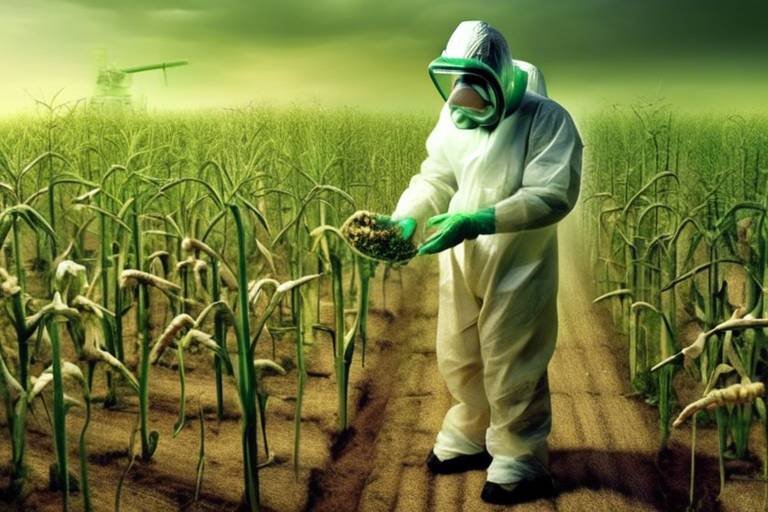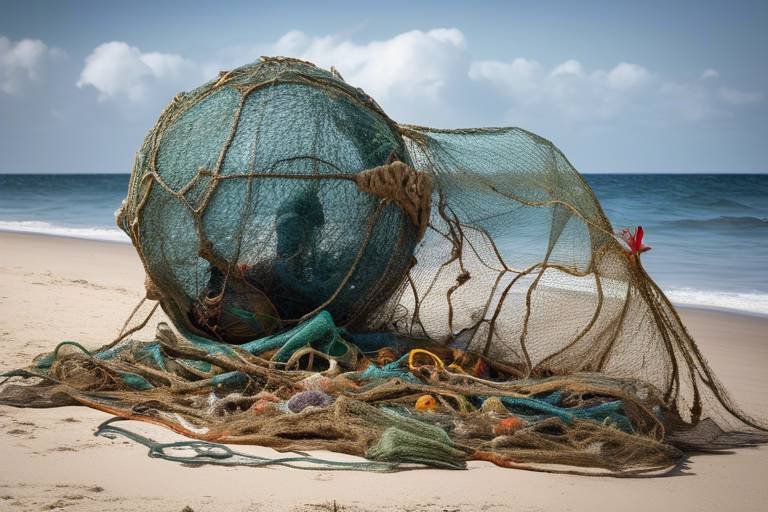Biodiversity and Agriculture: Nurturing a Symbiotic Relationship
The intricate dance between biodiversity and agriculture is one of nature's most fascinating spectacles. Imagine a vibrant tapestry woven with countless threads, each representing a different species, all working together to create a resilient ecosystem. This article explores how these diverse ecosystems not only enhance agricultural productivity but also contribute to sustainability, ultimately addressing the challenges and benefits of this vital relationship.
Biodiversity is not just a buzzword; it is the backbone of agricultural success. It plays a crucial role in maintaining ecosystem services that are vital for agriculture, such as pollination, pest control, and soil health. These services are essential for food security and help build resilience against climate change. For instance, when a variety of pollinators are present, crops can produce more fruit, leading to a more bountiful harvest. Similarly, diverse soil organisms contribute to nutrient cycling, which enhances soil fertility and crop yield.
However, not all agricultural practices are friendly to biodiversity. Intensive farming methods often lead to habitat destruction and the loss of species. The widespread use of pesticides and fertilizers can disrupt natural ecosystems, leading to a decline in pollinators and other beneficial organisms. Understanding these impacts is essential for developing sustainable farming methods that protect and promote biodiversity.
When we look at farming practices, a stark contrast emerges between monoculture and polyculture. Monoculture farming, which focuses on a single crop, can significantly diminish biodiversity. Picture a vast field of corn stretching as far as the eye can see—while it may be economically efficient, it leaves little room for other species to thrive. In contrast, polyculture systems, which encourage a variety of species, enhance ecosystem stability and resilience. By incorporating multiple crops, farmers can create a more balanced ecosystem that is less susceptible to pests and diseases.
Polyculture systems offer numerous advantages. They can:
- Increase crop yields by promoting a diverse range of plants.
- Improve soil health through the natural interactions between different species.
- Reduce pest outbreaks, as diverse crops can confuse pests and deter them from establishing populations.
These benefits showcase the undeniable advantages of integrating biodiversity into agricultural practices. It’s like planting a garden where every flower, herb, and vegetable supports one another, creating a lush and productive environment.
Despite its many benefits, transitioning to polyculture can be challenging. Farmers often face economic constraints, knowledge gaps, and market demands for uniformity in crops. The pressure to produce large quantities of a single crop can overshadow the long-term benefits of biodiversity. It’s akin to swimming against the current—while the destination is promising, the journey can be tough.
Implementing conservation strategies such as agroforestry and organic farming can help protect biodiversity while promoting sustainable agricultural practices. Agroforestry, for example, integrates trees and shrubs into crop and livestock systems, creating habitats for wildlife and enhancing soil quality. Organic farming practices eschew synthetic chemicals, fostering a healthier ecosystem and promoting biodiversity.
As if the challenges weren’t enough, climate change poses significant threats to biodiversity, impacting agricultural productivity. Rising temperatures, changing precipitation patterns, and extreme weather events can disrupt ecosystems, making it crucial to understand these effects. Developing adaptive strategies is essential to ensure food security in changing climates.
One way to combat the effects of climate change is by developing and promoting resilient crop varieties. These crops are bred to withstand extreme conditions, ensuring that ecosystems remain diverse and productive. By focusing on resilience, we can create a buffer against the unpredictable whims of nature.
Indigenous agricultural practices often incorporate principles of biodiversity and sustainability. These time-tested techniques provide valuable insights and methods that can enhance modern agricultural systems while preserving local ecosystems. For instance, traditional knowledge about crop rotation and the use of native plants can inform contemporary practices, creating a bridge between past and present.
Looking ahead, integrating biodiversity into agricultural policies and practices will be essential for achieving sustainable development goals. As we navigate the complexities of food production and ecosystem health, it’s vital to recognize that a balanced relationship is not just beneficial, but necessary for our planet’s future. By nurturing this symbiotic relationship, we can cultivate a world where agriculture and biodiversity thrive hand in hand.
- Why is biodiversity important for agriculture? Biodiversity enhances ecosystem services like pollination, pest control, and soil health, which are crucial for food production and resilience.
- What are the benefits of polyculture farming? Polyculture can increase yields, improve soil health, and reduce pest outbreaks, creating a more stable agricultural system.
- How does climate change affect biodiversity? Climate change impacts ecosystems through altered weather patterns and extreme conditions, threatening species and agricultural productivity.
- What role do indigenous practices play in agriculture? Indigenous practices often emphasize biodiversity and sustainability, offering valuable insights for modern farming techniques.

The Importance of Biodiversity in Agriculture
Biodiversity is not just a buzzword; it’s the backbone of our agricultural systems. Imagine a world where every crop you grow thrives in harmony with the surrounding ecosystem. That’s the magic of biodiversity! It plays a crucial role in maintaining essential ecosystem services that are vital for agriculture. These services include pollination, pest control, and soil health, which are all foundational elements for food production and security.
Pollination, for instance, is a natural service provided by various insects, birds, and even bats. Without these pollinators, many of our fruits and vegetables would struggle to reproduce. Did you know that about 75% of the world’s food crops depend on animal pollination? That’s a staggering statistic! When we protect biodiversity, we’re essentially safeguarding the very agents that help our crops flourish.
Moreover, biodiversity enhances soil health, which is critical for sustainable agriculture. Diverse plant species contribute to a rich soil microbiome, improving nutrient cycling and soil structure. This means healthier crops that are more resilient to diseases and pests. In contrast, monoculture practices, where farmers grow a single crop year after year, can deplete the soil of nutrients and make it more susceptible to erosion and pests.
Another significant aspect is the role of biodiversity in climate resilience. As climate change continues to impact weather patterns, having a diverse range of crops can act as a buffer. Different species respond uniquely to environmental stresses, so a varied crop system can help ensure that some plants will thrive even when conditions are less than ideal. This diversity can be the difference between a bountiful harvest and a failed one.
In addition to these benefits, biodiversity also supports food security. By cultivating a variety of crops, farmers can reduce their dependence on any single species, which can be particularly risky in the face of diseases or market fluctuations. In essence, a diverse agricultural system is a more stable one.
To summarize, the importance of biodiversity in agriculture cannot be overstated. It enhances ecosystem services, promotes soil health, increases resilience to climate change, and bolsters food security. As we move forward, embracing biodiversity in our agricultural practices will be essential for creating sustainable food systems that can withstand the challenges of tomorrow.
- Why is biodiversity important for farmers? Biodiversity helps improve crop yields, enhances soil health, and provides natural pest control, making farming more sustainable and resilient.
- How does biodiversity affect food security? A diverse range of crops can reduce dependence on a single species, ensuring that food supply remains stable even in adverse conditions.
- What are some ways to promote biodiversity in agriculture? Farmers can practice crop rotation, polyculture, and agroforestry to enhance biodiversity on their farms.

Impact of Agricultural Practices on Biodiversity
Agricultural practices have a profound impact on biodiversity, often acting as a double-edged sword. On one hand, they can enhance productivity and food security, but on the other, they can lead to significant ecological consequences. The shift towards intensive farming methods has resulted in habitat destruction, soil degradation, and a drastic decline in species diversity. This is particularly concerning as biodiversity is not just a luxury; it is a necessity for sustainable agriculture.
When we think about traditional farming, it often conjures images of lush fields teeming with various plants and animals. However, the reality of modern agriculture is starkly different. The prevalence of monoculture—growing a single crop over vast areas—has become the norm. This practice can lead to a cascade of negative effects on biodiversity:
- Habitat Loss: Large-scale farming operations often clear vast tracts of land, eliminating habitats for countless species.
- Soil Degradation: Intensive farming can strip the soil of nutrients and microorganisms that are vital for a healthy ecosystem.
- Pesticide Use: The reliance on chemical pesticides can decimate non-target species, including pollinators like bees, which are crucial for crop production.
Moreover, the loss of genetic diversity within crops can lead to increased vulnerability to pests and diseases. Imagine a world where a single disease could wipe out an entire crop—this is the reality faced when biodiversity is compromised. The consequences are not just environmental; they ripple through economies and communities that depend on agriculture for their livelihoods.
To counter these negative impacts, many are advocating for sustainable practices that promote biodiversity. This includes methods such as agroecology and organic farming, which prioritize ecological balance. For instance, incorporating cover crops and crop rotation can enhance soil health and biodiversity, creating a more resilient agricultural system.
Additionally, the integration of hedgerows, wildflower strips, and other natural habitats within agricultural landscapes can provide refuge for various species, promoting a more biodiverse ecosystem. These practices not only help sustain wildlife but also benefit farmers by improving pest control and pollination services, ultimately leading to higher yields.
In summary, the impact of agricultural practices on biodiversity is significant and multifaceted. While modern farming methods have improved efficiency and productivity, they have also led to alarming declines in biodiversity. The challenge lies in finding a balance—one that allows us to produce enough food without sacrificing the health of our ecosystems. As we move forward, embracing sustainable agricultural practices will be essential for protecting biodiversity and ensuring a resilient food system for future generations.
- What is biodiversity and why is it important for agriculture? Biodiversity refers to the variety of life in a particular habitat or ecosystem. It is crucial for agriculture because it enhances ecosystem services such as pollination, pest control, and soil health, all of which contribute to food security.
- How do intensive agricultural practices harm biodiversity? Intensive agricultural practices often lead to habitat destruction, soil degradation, and reliance on chemical pesticides, which can decimate non-target species and reduce genetic diversity in crops.
- What are some sustainable practices that can promote biodiversity in agriculture? Sustainable practices include agroecology, organic farming, crop rotation, and integrating natural habitats within agricultural landscapes, all of which can enhance biodiversity and ecosystem resilience.

Monoculture vs. Polyculture
When we dive into the world of agriculture, one of the most significant debates revolves around monoculture and polyculture. Monoculture refers to the practice of growing a single crop over a wide area for consecutive seasons. While this method can lead to short-term gains in productivity, it often comes at a steep ecological price. Imagine a vast field of corn stretching endlessly, but beneath that surface lies a fragile ecosystem struggling to survive. This lack of biodiversity can make crops more vulnerable to pests and diseases, leading to increased reliance on chemical pesticides and fertilizers.
On the flip side, we have polyculture, a farming practice that promotes the cultivation of multiple crops in the same space. Think of it as a colorful patchwork quilt, where each crop contributes to a vibrant ecosystem. Polyculture systems mimic natural ecosystems, enhancing resilience and stability. By planting a variety of species, farmers can create a balanced environment that supports pollinators, beneficial insects, and soil health. For instance, intercropping legumes with grains can improve nitrogen levels in the soil, reducing the need for synthetic fertilizers.
Let’s break down some of the key differences between these two approaches:
| Aspect | Monoculture | Polyculture |
|---|---|---|
| Diversity | Low | High |
| Pest and Disease Resistance | Vulnerable | More Resilient |
| Soil Health | Degrades Over Time | Improves Soil Quality |
| Yield Stability | Variable | More Consistent |
While the benefits of polyculture are clear, transitioning from monoculture to polyculture can feel like a daunting task for many farmers. Economic pressures, a lack of knowledge about diverse cropping systems, and market demands for uniformity can create significant barriers. Farmers often worry about the immediate financial implications of switching practices, especially when the market favors single-crop harvesting.
However, the long-term benefits of polyculture cannot be overstated. By fostering biodiversity, farmers can enhance their land's productivity and sustainability. It’s not just about growing food; it’s about nurturing a thriving ecosystem that can withstand the challenges of climate change and environmental degradation. So, the next time you see a field of crops, consider the story behind those plants. Are they standing alone, or are they part of a rich tapestry that supports life?

Benefits of Polyculture Systems
Polyculture systems, which involve cultivating multiple crops in the same space, offer a myriad of benefits that significantly enhance agricultural productivity and sustainability. One of the standout advantages is the increased crop yield. When farmers diversify their crops, they create a more resilient ecosystem that can withstand pests and diseases better than monoculture systems. For instance, if one crop fails due to a pest outbreak, others may thrive, providing a safety net for farmers and ensuring a more stable food supply.
Moreover, polyculture promotes soil health. Different plants have varying nutrient requirements and root structures, which can lead to improved soil structure and fertility. For example, deep-rooted plants can help break up compacted soil, while legumes can fix nitrogen, enriching the soil for subsequent crops. This natural nutrient cycling reduces the need for synthetic fertilizers, which can be harmful to the environment.
Another significant benefit is the reduction of pest outbreaks. Diverse plantings can confuse pests and reduce their populations. Certain plants can even attract beneficial insects that prey on pests, creating a natural pest control system. This leads to a decrease in pesticide use, benefiting both the environment and human health.
Additionally, polyculture systems can enhance biodiversity on farms. By cultivating a variety of crops, farmers can create habitats for a range of species, including pollinators like bees and butterflies. This not only supports ecosystem health but also improves pollination services, which are vital for many crops.
To sum it up, the benefits of polyculture systems can be summarized as follows:
- Increased Crop Yields: A diverse planting strategy can lead to higher overall production.
- Improved Soil Health: Different crops contribute to better soil structure and fertility.
- Natural Pest Control: Diverse crops can help manage pest populations effectively.
- Enhanced Biodiversity: Polyculture supports a wider range of species on farms.
Ultimately, by embracing polyculture, farmers can not only improve their productivity but also contribute to a healthier planet. This symbiotic relationship between agriculture and biodiversity is crucial for building a sustainable future.
Q: What is polyculture?
A: Polyculture is an agricultural practice that involves growing multiple species of crops in the same area simultaneously. This approach contrasts with monoculture, where only one crop is grown.
Q: How does polyculture improve soil health?
A: Different crops have unique root structures and nutrient needs, which can enhance soil structure, prevent erosion, and promote nutrient cycling, leading to healthier soil over time.
Q: Are there any disadvantages to polyculture?
A: While polyculture has many benefits, it can also present challenges such as increased complexity in management and potential difficulties in harvesting. However, the long-term benefits often outweigh these challenges.
Q: Can polyculture help with climate change?
A: Yes, by promoting biodiversity and resilience in agricultural systems, polyculture can help mitigate the impacts of climate change on food production.

Challenges of Implementing Polyculture
Transitioning to polyculture systems is not as simple as it sounds. While the benefits are clear, the road to implementing these diverse farming practices can be riddled with obstacles. One of the most significant challenges is economic constraints. Farmers often operate on tight budgets, and the initial investment required to shift from monoculture to polyculture can be daunting. This includes costs related to seeds, tools, and even education on new farming techniques.
Furthermore, there’s a knowledge gap that can hinder the successful adoption of polyculture. Many farmers have been trained in traditional monoculture methods, and the lack of familiarity with polyculture can lead to uncertainty. They might wonder, “How do I manage multiple crops effectively?” or “Will this really yield better results?” Such questions are valid and highlight the need for comprehensive training programs that can equip farmers with the necessary skills.
Another challenge is the market demand for uniformity. Consumers often prefer aesthetically pleasing, uniform produce, which can make it difficult for polyculture farmers to compete. This demand for homogeneity can pressure farmers to revert to monoculture practices, even if they recognize the long-term benefits of biodiversity. Additionally, distribution channels are often set up to handle single crops, making it logistically complex for polyculture farms to market their diverse produce.
Lastly, there’s the issue of policy support. In many regions, agricultural policies favor large-scale monoculture operations, providing subsidies and incentives that are not available for polyculture systems. This lack of support can discourage farmers from making the switch, as they may feel they are at a disadvantage compared to their monoculture counterparts. To overcome these challenges, a collaborative effort involving farmers, policymakers, and researchers is essential. By working together, they can create a more favorable environment for polyculture, ensuring that biodiversity thrives alongside agricultural productivity.
- What is polyculture? Polyculture is an agricultural practice that involves growing multiple crops in the same space at the same time, as opposed to monoculture, which focuses on a single crop.
- What are the benefits of polyculture? Polyculture can enhance biodiversity, improve soil health, reduce pest outbreaks, and increase crop resilience against climate change.
- Why do farmers struggle to implement polyculture? Economic constraints, knowledge gaps, market demands for uniformity, and lack of policy support are significant challenges that farmers face when transitioning to polyculture.
- How can farmers be supported in transitioning to polyculture? Providing education, financial incentives, and creating favorable policies can help farmers successfully adopt polyculture practices.

Conservation Strategies in Agriculture
Conservation strategies in agriculture are essential for promoting biodiversity while ensuring sustainable farming practices. These strategies not only help protect the environment but also enhance the resilience of agricultural systems. One prominent method is agroforestry, which integrates trees and shrubs into crop and livestock systems. This practice can significantly improve soil health, reduce erosion, and provide habitats for various species. Imagine a farm where crops grow alongside towering trees, creating a mini-ecosystem that supports both plants and wildlife!
Another effective strategy is organic farming, which avoids synthetic fertilizers and pesticides. By relying on natural processes, organic farming can enhance soil fertility and promote a diverse range of organisms in the soil. This approach not only benefits the environment but also produces healthier food for consumers. For instance, organic farms often have a higher diversity of insects and other organisms, which can lead to improved pest control and pollination. The ripple effect of these practices can be profound, leading to a more balanced ecosystem and a healthier planet.
Additionally, cover cropping is a conservation strategy that plays a crucial role in maintaining soil health and preventing erosion. By planting cover crops during the off-season, farmers can improve soil structure, increase organic matter, and suppress weeds. This practice not only enhances biodiversity in the soil but also contributes to better water retention and nutrient cycling. Picture a field blanketed with vibrant green cover crops, acting as a protective shield for the soil beneath.
Moreover, conservation tillage is another technique that minimizes soil disturbance, thereby preserving soil structure and biodiversity. By reducing the frequency and intensity of tilling, farmers can maintain the habitat for beneficial organisms such as earthworms and microorganisms. This method can lead to healthier soils and improved crop yields over time. The relationship between the soil and the crops can be likened to a partnership, where both parties work together for mutual benefit.
Incorporating these conservation strategies requires a shift in mindset among farmers and policymakers. Education and training programs are vital to equip farmers with the knowledge and skills necessary to implement these practices effectively. As we move forward, collaboration between agricultural stakeholders, conservationists, and researchers will be crucial in developing innovative solutions that protect biodiversity while maintaining agricultural productivity.
In summary, conservation strategies such as agroforestry, organic farming, cover cropping, and conservation tillage are not just buzzwords; they represent a pathway to a more sustainable and resilient agricultural future. By embracing these practices, we can nurture a symbiotic relationship between agriculture and biodiversity, ensuring a healthier planet for generations to come.
- What is agroforestry? Agroforestry is a land management practice that combines trees and shrubs with crops and livestock to create a more diverse and sustainable farming system.
- How does organic farming benefit biodiversity? Organic farming avoids synthetic chemicals, promoting healthier soils and a wider range of organisms, which can lead to better pest control and pollination.
- What are cover crops, and why are they important? Cover crops are plants grown during the off-season to protect and enrich the soil. They improve soil health, prevent erosion, and enhance biodiversity.
- What is conservation tillage? Conservation tillage is a farming practice that minimizes soil disturbance, helping to maintain soil structure and support beneficial organisms.

Climate Change and Biodiversity
Climate change is not just a buzzword; it's a reality that affects every corner of our planet, and its impact on biodiversity is profound. As temperatures rise and weather patterns shift, many species are struggling to adapt. This struggle can lead to a decline in biodiversity, which in turn affects agricultural productivity. Imagine a world where our crops fail because the natural systems that support them are in disarray. Scary, right? That's why understanding the intricate relationship between climate change and biodiversity is crucial for our future.
One of the most significant threats posed by climate change is the alteration of habitats. As ecosystems change, many species find their home environments transformed or even destroyed. This loss of habitat can lead to a domino effect, where the decline of one species impacts others that rely on it for food or shelter. For instance, pollinators like bees are sensitive to temperature changes. If their habitats are compromised, the plants they pollinate suffer, leading to lower crop yields. It's a vicious cycle that can threaten food security globally.
Moreover, climate change can exacerbate the spread of pests and diseases. Warmer temperatures can expand the range of harmful insects and pathogens, putting additional pressure on crops and livestock. Farmers may find themselves battling pests that were previously non-existent in their regions, leading to increased use of pesticides. This not only harms the environment but also diminishes biodiversity as chemical runoff can contaminate nearby ecosystems.
To combat these challenges, developing and promoting resilient crop varieties is essential. These varieties are bred to withstand extreme weather conditions, pests, and diseases, ensuring that they can thrive even in a changing climate. By integrating biodiversity into agricultural practices, farmers can create a buffer against the unpredictable impacts of climate change. Think of it as planting a safety net that can catch us when the storms hit.
Furthermore, indigenous agricultural practices offer valuable insights into sustainable farming. These practices often emphasize the importance of biodiversity and have been honed over generations. By learning from these time-tested methods, modern agriculture can incorporate traditional knowledge to enhance resilience against climate change. This synergy between indigenous wisdom and modern science can lead to innovative solutions that benefit both farmers and the environment.
In conclusion, the relationship between climate change and biodiversity is complex and multifaceted. As we face the challenges of a warming world, prioritizing biodiversity in agricultural practices is more important than ever. By nurturing this connection, we can work towards a sustainable future where both our ecosystems and food systems thrive.
- How does climate change affect biodiversity?
Climate change alters habitats, affects species' ability to adapt, and can lead to declines in biodiversity, impacting ecosystem services critical for agriculture. - What are resilient crop varieties?
These are crops bred to withstand extreme weather conditions, pests, and diseases, ensuring agricultural productivity even under challenging climate scenarios. - What role do indigenous practices play in sustainable agriculture?
Indigenous practices often incorporate biodiversity principles and sustainable techniques that can enhance modern agricultural systems while preserving local ecosystems.

Resilient Crop Varieties
In the face of climate change and its unpredictable effects on agriculture, the development of has emerged as a beacon of hope for farmers and ecosystems alike. These varieties are specifically bred or selected for their ability to withstand harsh conditions such as drought, floods, pests, and diseases. Imagine a farmer standing in a field, knowing that their crops can thrive even when the weather throws a tantrum. That’s the power of resilient crops!
One of the key benefits of these resilient varieties is their potential to enhance food security. As global populations continue to rise, the demand for food increases, and traditional crops may not be able to keep pace due to changing climatic conditions. By focusing on resilience, we create a safety net that ensures farmers can produce enough food despite environmental challenges. For instance, varieties of rice and wheat have been developed to tolerate saline soils, enabling cultivation in areas previously deemed unfit for farming.
Furthermore, resilient crops contribute to biodiversity. By incorporating a variety of traits from different species, these crops can support a wider range of insects and wildlife, promoting a healthier ecosystem. The relationship between biodiversity and resilient crops is like a symbiotic dance; each partner enhances the other's strengths. For example, planting diverse crop varieties can attract beneficial insects that naturally control pests, reducing the need for chemical pesticides.
However, developing resilient crop varieties is not without its challenges. It requires significant investment in research and development, as well as collaboration between scientists, farmers, and policymakers. The process of breeding these crops can be time-consuming and complex, often involving advanced techniques such as genetic modification or traditional cross-breeding. But the payoff is worth it: healthier crops, sustainable practices, and a more secure food future.
To give you a clearer picture, here’s a table showcasing some examples of resilient crop varieties and their specific traits:
| Crop Variety | Resilience Trait | Benefits |
|---|---|---|
| IR64 Rice | Flood tolerance | Grows well in submerged conditions, ensuring food supply during heavy rains. |
| Salt-Tolerant Wheat | Saline soil tolerance | Expands arable land in coastal areas, enhancing food production. |
| Bt Cotton | Pest resistance | Reduces the need for chemical pesticides, promoting environmental health. |
In conclusion, the development of resilient crop varieties stands at the intersection of agriculture and biodiversity, providing a pathway to sustainable farming practices. By investing in these crops, we not only secure our food supply but also nurture the ecosystems that support us. As we look to the future, it’s clear that resilient crops will play a vital role in ensuring that agriculture can adapt and thrive amidst the challenges posed by climate change.
- What are resilient crop varieties? Resilient crop varieties are specially bred or selected crops that can withstand adverse conditions such as drought, pests, and diseases.
- Why are resilient crops important? They enhance food security, support biodiversity, and enable farmers to produce food despite changing climatic conditions.
- How are resilient crops developed? Through research and development, using techniques like genetic modification and traditional breeding methods.
- Can resilient crops help with pest management? Yes, by attracting beneficial insects, they can naturally control pest populations, reducing the need for chemical pesticides.

Role of Indigenous Practices
Indigenous agricultural practices are a treasure trove of knowledge that has been honed over centuries. These time-tested methods often prioritize biodiversity and sustainability, offering a refreshing contrast to modern industrial farming techniques. By integrating local ecosystems into their farming practices, indigenous communities not only cultivate food but also maintain the delicate balance of their environments.
One of the key aspects of indigenous practices is their emphasis on diversity. For instance, many indigenous farmers utilize a mix of crops, livestock, and wild plants, which fosters a rich tapestry of life. This biodiversity is not merely for show; it serves practical purposes. Different plants can attract various pollinators and beneficial insects, which can help control pests naturally. In addition, a diverse set of crops can enhance soil health and reduce the risk of total crop failure due to disease or extreme weather events.
Moreover, indigenous practices often include traditional ecological knowledge (TEK). This encompasses a deep understanding of local flora and fauna, soil types, and weather patterns. For example, indigenous farmers may know the best times to plant certain crops based on the lunar calendar or specific seasonal indicators. This profound connection to the land allows them to adapt their practices in response to changing environmental conditions, ensuring sustainability for future generations.
However, it's important to recognize that these practices face challenges. Modern agricultural policies and market demands often prioritize uniformity and high yields over biodiversity. This can lead to the marginalization of indigenous methods, pushing them to the brink of extinction. To combat this, there is a growing movement to integrate indigenous knowledge into mainstream agricultural practices. By doing so, we can create a more resilient and sustainable food system that honors the wisdom of those who have cultivated the land for generations.
Incorporating indigenous practices into contemporary agriculture not only benefits the environment but also supports food sovereignty. This means empowering local communities to control their food systems, ensuring they have access to nutritious food while preserving their cultural heritage. Ultimately, the role of indigenous practices in agriculture is not just about farming; it's about fostering a holistic relationship with nature that can inspire future generations to cherish and protect our planet's biodiversity.
- What are indigenous agricultural practices?
Indigenous agricultural practices refer to traditional farming methods that have been developed and refined by local communities over generations, emphasizing sustainability and biodiversity.
- How do these practices contribute to biodiversity?
These practices often involve growing a variety of crops and using natural pest control methods, which help maintain healthy ecosystems and promote biodiversity.
- Can indigenous practices help combat climate change?
Yes, by fostering diverse ecosystems and sustainable practices, indigenous agriculture can enhance resilience to climate change and contribute to food security.
- Why are indigenous practices often overlooked in modern agriculture?
Modern agricultural policies frequently prioritize high yields and uniformity, which can overshadow the benefits of diverse and traditional methods.

Future Directions for Biodiversity and Agriculture
As we look to the future, the relationship between biodiversity and agriculture is more crucial than ever. The challenges posed by climate change, population growth, and food security demand innovative approaches that integrate ecological principles into farming practices. One promising direction is the adoption of sustainable agricultural policies that prioritize biodiversity. This involves not just protecting existing ecosystems but actively enhancing them to support agricultural productivity.
For instance, incorporating agroecological practices can create a more resilient agricultural system. These practices emphasize the use of local resources, crop rotations, and intercropping, which can help maintain soil health and reduce dependency on chemical fertilizers. By embracing these methods, farmers can cultivate a diverse range of crops that not only yield better but also contribute to the overall health of the ecosystem.
Moreover, collaboration among stakeholders is essential. Farmers, policymakers, scientists, and local communities must work together to create frameworks that support biodiversity-friendly practices. This can be achieved through:
- Education and Training: Providing farmers with the knowledge and tools needed to implement sustainable practices.
- Financial Incentives: Offering subsidies or grants for farmers who adopt biodiversity-enhancing practices.
- Research and Development: Investing in research to develop crop varieties that are resilient to pests and climate change.
Another significant aspect of future agricultural practices is the integration of technology. Precision agriculture, for example, utilizes data analytics and IoT (Internet of Things) devices to monitor crop health and optimize resource use. This technology can help farmers make informed decisions that favor both yield and biodiversity.
Additionally, the role of indigenous knowledge cannot be overlooked. Indigenous communities have long understood the importance of biodiversity in agriculture, often employing sustainable methods that have been passed down through generations. By incorporating these traditional practices into modern agriculture, we can create systems that are not only productive but also ecologically sound.
To sum up, the future of biodiversity and agriculture lies in a multifaceted approach that combines sustainable practices, stakeholder collaboration, technological advancement, and respect for indigenous knowledge. By prioritizing these elements, we can ensure that food production and ecosystem health go hand in hand, paving the way for a sustainable future.
1. Why is biodiversity important for agriculture?
Biodiversity is essential for agriculture as it supports ecosystem services such as pollination, pest control, and soil health, all of which contribute to food security and resilience against climate change.
2. What are polyculture systems?
Polyculture systems involve growing multiple crops in the same space, which can enhance biodiversity, improve soil health, and reduce pest outbreaks compared to monoculture systems.
3. How can farmers transition to sustainable practices?
Farmers can transition by educating themselves on sustainable methods, collaborating with local agricultural organizations, and utilizing financial incentives from government programs.
4. What role does technology play in sustainable agriculture?
Technology, such as precision agriculture, helps farmers monitor crop health and optimize resource use, leading to improved yields while promoting biodiversity.
5. How can indigenous practices contribute to modern agriculture?
Indigenous practices often emphasize sustainability and biodiversity, providing valuable insights that can enhance modern agricultural systems while preserving local ecosystems.
Frequently Asked Questions
-
What is the role of biodiversity in agriculture?
Biodiversity is vital for agriculture as it supports ecosystem services like pollination, pest control, and soil health. These services are crucial for enhancing agricultural productivity and ensuring food security, especially in the face of climate change.
-
How do agricultural practices impact biodiversity?
Intensive agricultural practices, such as monoculture, often lead to habitat destruction and a decline in species diversity. Understanding these impacts is essential for developing sustainable farming methods that protect and promote biodiversity.
-
What are the benefits of polyculture systems?
Polyculture systems promote a variety of species, which can lead to increased crop yields, improved soil health, and reduced pest outbreaks. By integrating biodiversity, these systems enhance ecosystem stability and resilience.
-
What challenges do farmers face when transitioning to polyculture?
Farmers may encounter economic constraints, gaps in knowledge about polyculture practices, and market demands for uniform crops. These challenges can make it difficult to shift from conventional monoculture to more diverse farming systems.
-
What conservation strategies can be implemented in agriculture?
Strategies like agroforestry and organic farming can help protect biodiversity while promoting sustainable agricultural practices. These approaches benefit both farmers and the environment by fostering a healthy ecosystem.
-
How does climate change affect biodiversity in agriculture?
Climate change poses significant threats to biodiversity, which can impact agricultural productivity. Understanding these effects is crucial for developing adaptive strategies to ensure food security in changing climates.
-
What are resilient crop varieties?
Resilient crop varieties are those that can withstand the impacts of climate change, such as drought or pests. Promoting these varieties helps maintain ecosystem diversity and agricultural productivity in challenging conditions.
-
How do indigenous practices contribute to biodiversity in agriculture?
Indigenous agricultural practices often incorporate principles of biodiversity and sustainability. These practices provide valuable insights and techniques that can enhance modern agricultural systems while preserving local ecosystems.
-
What future directions should be taken for biodiversity and agriculture?
Integrating biodiversity into agricultural policies and practices is essential for achieving sustainable development goals. This balanced approach ensures that food production does not come at the expense of ecosystem health.



















